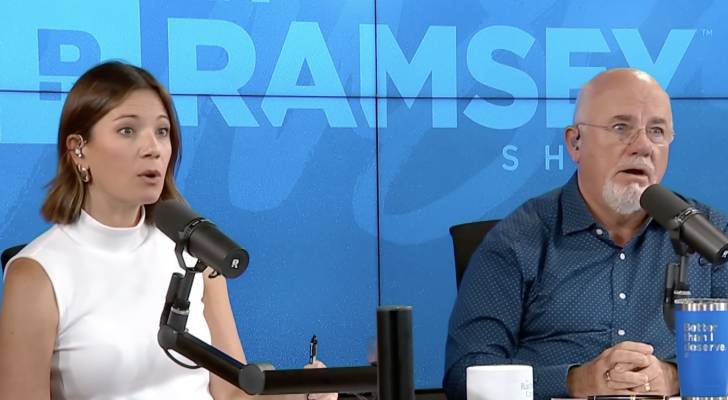‘Too old to be having these problems’: Cincinnati mom left ‘confused’ after partner walked out on her when they found out she was pregnant — so Dave Ramsey helped her build a ‘baby budget’


Johi called into the The Ramsey Show from Cincinnati, reeling from a week in which her boyfriend of 14 years deserted her — right after she discovered she was pregnant with their second child. “He was just not ready to take on that responsibility, so he left,” she said. They already have a 12-year-old child […]
‘Fight these goobers’: Washington State man has debt collectors coming after him — but Dave Ramsey thinks negotiating with them should be at the bottom of his to-do list


Jordan from Spokane, Washington, has collection agencies coming after him, so he called into The Ramsey Show for help negotiating with debt collectors. In particular, a repo agent — also known as a repossession agent, who is employed by a collection agency to repossess property over a failure to make contractual payments — has been […]
I’m 59 and inching closer to retirement — but after a nasty divorce, I’ve been left with basically zero savings. What 3 things can I do ASAP to cobble together a comfortable nest egg?


Jamie, 59, is inching closer to retirement, but after going through a nasty divorce, his emergency fund and savings have been wiped out. He still has a 401(k), a pension and some investments, but his divorce will impact the value of those assets. Without additional savings to supplement those assets — which will be divided […]
My wife and I are well off but we told our daughter, 21, we couldn’t afford to pay for her college — now she’s graduated with $90K in student loans and a chip on her shoulder. What now?
Picture this: James and his wife Nola, both 62, have done well in life, earning a combined income that gives them an upper-class lifestyle. But, when their daughter Tia went to college, they told her they couldn’t afford to pay her way. Most of their money is tied up in investments and employer-sponsored retirement plans, […]
I’m 57 years old and recently divorced. I walked away from my marriage with just $18K in retirement savings — with only about 10 years to catch up, how do I secure my suddenly solo future?


Divorce isn’t just a young person’s game. For some, love is fleeting and can evaporate quickly. In other cases, it’s a bond that can last for decades until it’s worn down or suddenly broken. Kathryn, 57, finds herself single after nearly 30 years of marriage. Her ex was the breadwinner of the household, and she […]
My husband died suddenly last year after a short illness — can I collect his Social Security and my own at the same time or would that cause problems?


Janice’s husband died suddenly last year after having a stroke. The couple were a few years away from retirement. Janice, 62, was waiting to claim Social Security at 65 when she’d also be eligible for Medicare benefits. Her late husband made more money over the course of his career, so he would have received a […]
‘You willfully ruined people’s lives’: Florida man to spend 20 years behind bars for swindling customers out of $1.3M — leaving them with unfinished pools and ‘a shattered sense of security’


Putting a pool in your backyard is a major decision — costing upwards of $100,000, according to HomeGuide — that inevitably involves disruption. But for Tampa Bay-area clients of Olympus Pools, the cost and disruption were far more than they bargained for. As WFLA News Channel 8 reports, hundreds were left with nothing but holes […]
‘Trash that is passed as news’: Donald Trump orders funding halt for ‘biased’ PBS, NPR — and even took a swipe at Sesame Street. How this could hurt communities across the US


A new executive order signed by President Donald Trump calls for an immediate halt to federal funding of NPR and PBS, citing what he calls “biased and partisan news coverage.” A statement from the White House called the outlets “biased” with “trash that is passed as news.” The order directs the Corporation for Public Broadcasting […]
‘Mind boggling’: Some Californians making six figures now qualify for low-income housing, as report reveals 41% of households there are ‘cost burdened’ — making it the highest rate in the US


California is in the midst of a housing affordability crisis. And whether you are renting or buying, “the salaries that people once strived for often are no longer enough,” reporter Steve Large with CBS News Sacramento said. Household income levels — based on the latest data from California’s Department of Housing and Community Development — […]
‘Gold’s not going to solve it’: Arizona man called into The Ramsey Show for advice on protecting his family in the case of ‘societal collapse’ — here’s the surprising advice they gave him


Chris from Phoenix is worried about “huge civil unrest” resulting from a collapsed dollar — and he doesn’t think President Donald Trump or billionaire Elon Musk can fix the situation. The dad of two young daughters called into The Ramsey Show and asked co-hosts George Kamel and Dr. John Delony for their thoughts on how […]